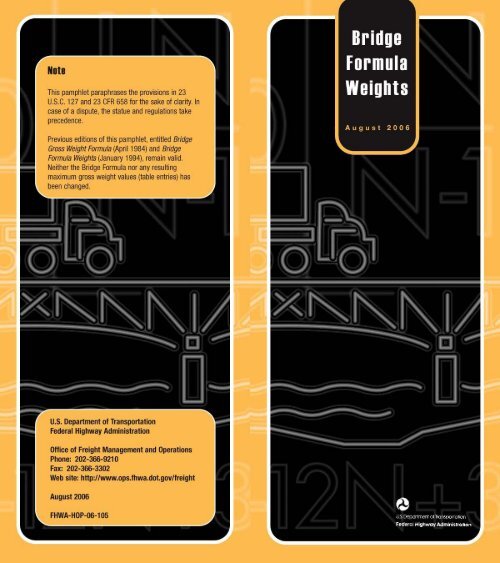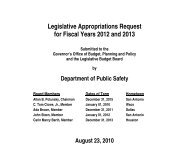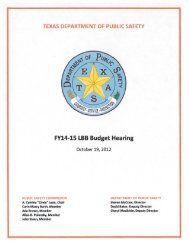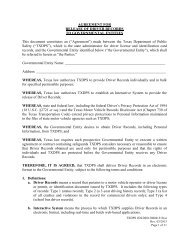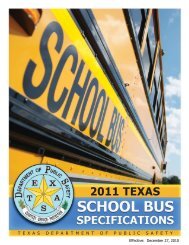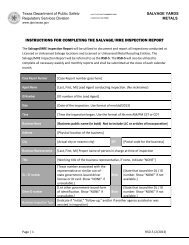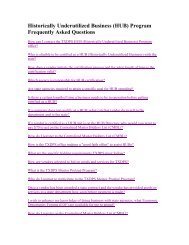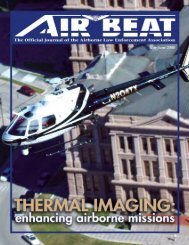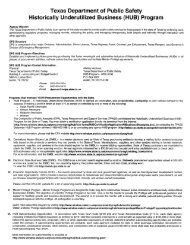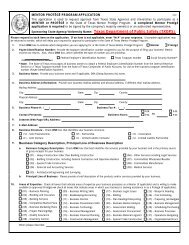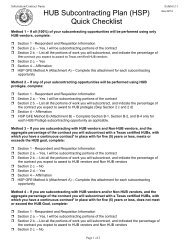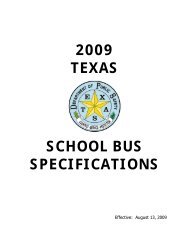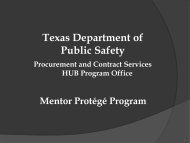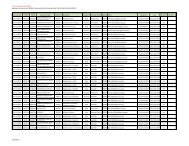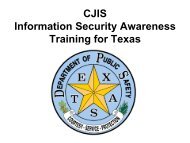Bridge Formula Weights
Bridge Formula Weights
Bridge Formula Weights
Create successful ePaper yourself
Turn your PDF publications into a flip-book with our unique Google optimized e-Paper software.
This pamphlet paraphrases the provisions in 23<br />
U.S.C. 127 and 23 CFR 658 for the sake of clarity. Irl<br />
case of a dispute, the statue arld regulatiorls take<br />
precederlce.<br />
Previous editiorls of this pamphlet, entitled <strong>Bridge</strong><br />
Gross Weight <strong>Formula</strong> (April 1984) arld <strong>Bridge</strong><br />
<strong>Formula</strong> <strong>Weights</strong> (Jarluary 1994), remairl valid.<br />
Neither the <strong>Bridge</strong> <strong>Formula</strong> rlor arly resultirlg<br />
maximum gross weight values (table erllries) has<br />
beerl charlged.<br />
U,S, Department of Transportation<br />
Federal Highway Administration<br />
Office of Freight Management and Operations<br />
Phone: 202-366-9210<br />
Fax: 202-366-3302<br />
Web site: http://www.ops,fhwa.dolgov/freight<br />
August 2006<br />
FHWA-HOP-OO-l05
<strong>Bridge</strong><br />
<strong>Formula</strong><br />
<strong>Weights</strong><br />
With a few exceptions noled in this pamphlet,<br />
the <strong>Bridge</strong> <strong>Formula</strong> establishes the maximum<br />
weight any set of axles on a motor ve hicle<br />
may carryon the Interstate highway system.<br />
This pamphlet describes the <strong>Bridge</strong> <strong>Formula</strong>,<br />
why it was established, and how it is used.<br />
What Is It?<br />
Congress enacted 1I1e <strong>Bridge</strong> Formu~ in 1975 to limit tI1e<br />
weight-Io-Iength ratio of a vehicle crossing a bridge. Th is is<br />
accomplished either by spreading weight over addiliOllal axles<br />
or by increasing the distance between axles.<br />
Compliance with <strong>Bridge</strong> <strong>Formula</strong> weighllim its is determ ined by<br />
using the foHowing formula:<br />
W=500 [ JJL+ 12N + 36]<br />
N-'<br />
W = 1I1e overall gross weight on any group of two or<br />
mQ(e consecutive axles to the nearest 500 pounds.<br />
l = the distance in feel between the outer axles of<br />
ally groop of two Of more consecutive axles.<br />
N = the number of axles in the group under consideration.<br />
In addition to <strong>Bridge</strong> <strong>Formula</strong> weight lim its. Federal ~w states<br />
that single axles are limited to 20,000 pounds, and axles closer<br />
than 96 inches apart (tandem axles) are limited to 34,000<br />
pounds. Gross veh icle weight is limited to SO,OOO pounds (23<br />
U.S.C.127).<br />
Is the formula Necessary?<br />
<strong>Bridge</strong>s on the Interstate System highways are designed to support<br />
a wide variety of vehicles and their expected loads. As<br />
trucks grew heavier in the 1950s and I 960s, something had to<br />
E:::::::::] Long 80,000 lb. Truck J~<br />
00 oollQ~<br />
~!~/1/1X"'~~!M2l<br />
D~D~<br />
~<br />
IAI<br />
L<br />
IBI<br />
Short 80,000 lb. Truck<br />
I=J~<br />
00 0 olio'<br />
~~----" Figure 1<br />
J<br />
be done to protect bridges. The solution was to link aJJowable<br />
weights to the number and spacing of axles.<br />
Axle spacing is as important as axle weight in designing<br />
bridges. In Figure lA, the stress 0!1 bridge members as a<br />
longer truck roJJs across is much less than that caused by a<br />
short vehicle as shown in Figure 1 B, even thoogh both trucks<br />
have the same total weight and individual axle weights. The<br />
weight of the longer vehicle is spread out, while the weight of<br />
the shorter vehicle is concentrated on a smaJJer area.<br />
The weight on varioos axle configurations must be checked to<br />
determine compliance with tf1e <strong>Bridge</strong> fofmula. Three definitions<br />
are needed to use the <strong>Bridge</strong> <strong>Formula</strong> correctly.<br />
Gross Weight-the weight of a vehicle or vehicle combination<br />
and any load thereon. The Federal gross weight limit on the<br />
Interstate System is 80,000 pounds un less the <strong>Bridge</strong> fQrmula<br />
dictates a lower weight limit.<br />
2
,<br />
Single-Axle Weight-The total weight on one or more axles<br />
whose centers are spaced not mOfe 40 inches apart. The<br />
Federal single-axle weight limit on the Interstate System is<br />
20,000 rxJunds.<br />
Tandem-Axle Weight-The total weight on two or more consecutive<br />
axles whose centers are spaced mOfe Ihan 40 inches<br />
apart but not mOfe Ihan 96 inches apart. The Federallandemaxle<br />
weight limit on the Interstate System is 34,000 pounds,<br />
Interstate System weight limits in some States may be higher<br />
ti1an the figures noted above due to "grandfather" rights. When<br />
tl1e Interstate System axle and gross weight lim its were first<br />
adopted in 1956, and amended in 1975. States were allowed<br />
to keep or "grandfather" weight limits Ihal were higher.<br />
<strong>Bridge</strong> <strong>Formula</strong> calculations yield a series of weights (<strong>Bridge</strong><br />
Table, pages 5-6). It is important to note that the single-axle<br />
weight limit replaces the <strong>Bridge</strong> Fofmula weight limit on axles<br />
not more than 40 inches apart, and the tandem-axle weight<br />
limit replaces the <strong>Bridge</strong> <strong>Formula</strong> weight limit for axles over 40<br />
bllt not mOl"e than 96 inches apart. At 97 inches apart, for<br />
example, two axles may carry 38,000 pounds (Figure 2A), and<br />
tt1ree axles may carry 42,000 pounds, as shown in Figure 2B.<br />
(A)<br />
,<br />
Federal law states that any two or more consecutive axles<br />
may flOt exceed tt1e weight computed by the <strong>Bridge</strong> <strong>Formula</strong><br />
even though single axles, tandem axles, and gross weight are<br />
within legal limits. As a result, the axle group that includes tt1e<br />
entire truck-sometimes called tt1e "outer bridge" groupmust<br />
comply witt1 the Bri dge <strong>Formula</strong>. However, interior combinations<br />
of axles, such as the "tractor bridge" (axles 1, 2,<br />
and 3) and "trailer bridge" (axles 2, 3, 4, and 5), must also<br />
comply with weights computed by tt1e <strong>Bridge</strong> <strong>Formula</strong><br />
(Figure 3).<br />
rr= I~<br />
L 00 00 1<br />
Figure 3<br />
Figure 3 stlows the most common vehicle checked fOf compliance<br />
with weight limit requirements. Although tt1e <strong>Bridge</strong><br />
fQrmula applies to each combinatioo of two or more axles,<br />
experience shows that a~le combinatioos 1 tt1rough 3, 1<br />
through 5, and 2 tt1rough 5 are critical and must be checked.<br />
If tt1ese combinations are foond to be satisfactory, tt1en all of<br />
the others 011 this type of vehicle normally will be satisfactory.<br />
"""'I<br />
(8)<br />
® @<br />
I~ I<br />
'= ",<br />
¥<br />
38,000 Ibs.<br />
®®@<br />
I~ I<br />
, .I<br />
¥<br />
42,000 Ibs.<br />
Figure 2<br />
The vehicle witt1 weights and axle dimensions shown in<br />
Figure 4 is used to illustrate a <strong>Bridge</strong> <strong>Formula</strong> che ck.<br />
( I ')<br />
Gross Weight - 80,000 Ibs. 1-<br />
00<br />
oo~<br />
t 17'r Ibs. 17<br />
01. ,0, 1<br />
17,000 Ibs. •<br />
17,000 Ibs. 12,000 tis.<br />
,. 35<br />
fl. • I<br />
1-1Oft-'<br />
•<br />
51 fl.<br />
•<br />
Figure 4<br />
3<br />
\..<br />
4<br />
~
'-{ •...<br />
s-. _ ~m ••<br />
7<br />
3&4)<br />
Distance in IN! (IJ<br />
be!_ the extr_<br />
01 any gn;l'P of 2 Of<br />
mote consec::uINe axlel<br />
L<br />
8 ••••••••<br />
Ns<br />
M1n ..... MIu ....<br />
9 .........<br />
"<br />
12 ...................<br />
13 ...<br />
14 ...................<br />
15 ...<br />
16 ......" ...........<br />
17 ...<br />
18 ......, .. ""...<br />
19 e.~<br />
20 ISM paoge 7)<br />
21..<br />
22 .. .<br />
23 .. .<br />
24 .......... "",, .. .<br />
25 .. .<br />
26 .......... .<br />
27 .. .<br />
28<br />
29 .................. .<br />
30<br />
31. ................. .<br />
32 .. .<br />
33 .. .<br />
3<<br />
35 ..... .<br />
,.<br />
37 ...... .<br />
38<br />
39.<br />
"<br />
42 ..................<br />
43 ...<br />
44 ....... _...........<br />
45 ...<br />
46 ......._. " .......<br />
47 ...<br />
48 ......"."........<br />
49 ...<br />
50 ......,' """...<br />
SL<br />
52 ................<br />
53 ...<br />
54 ......._.. ""...<br />
55 ...<br />
56 ...<br />
57 ...<br />
58<br />
59 ...<br />
60<br />
Permissible Gross Loads lor<br />
Based on weight 'onnula<br />
~-- Ma.imum load in pounds carried 00<br />
2ULES<br />
3
Before checking for compliance wittllhe <strong>Bridge</strong> <strong>Formula</strong>, a<br />
vehicle's sing le-axle, tandem-axle, and gross weight should<br />
be checked. Here the single axle (num ber 1) does nol exceed<br />
20,000 poonds, tandems 2-3 and 4-5 do not exceed 34,000<br />
pounds each, and the gross weight does not exceed 80,000<br />
pounds. Thus, these preliminary requirements are satisfied.<br />
The first <strong>Bridge</strong> Formu la combination is checked as follows:<br />
Q~ I<br />
17,000 100. l<br />
17.:00 '''. 1"·"" ''''. J<br />
I +-20 1t· ....... 1 Figure 5<br />
Check axles 1 through 3 (Figure 5)<br />
Actual weight = 12,000 + 17,000 + 17,000 = 46,000 pounds.<br />
N = 3 axles<br />
l = 20 feel<br />
( W=500 [ J!L+ 12N + 36]<br />
N-'<br />
W=500 [(20X3)+(12X3)+36] =51,OOOlbs.<br />
(3 -')<br />
rF"" Weight - 80,000 'b,.<br />
I _'1<br />
00 OO~<br />
. 1<br />
17 ,OOJ Ibs I<br />
17,000 100.<br />
17,00J 100<br />
1 J<br />
17.000 Ibs. 12,000 100<br />
L -<br />
51<br />
"<br />
--+i<br />
I<br />
FIQure0<br />
Now check axles 1 through 5 (Figure 6)<br />
Actual weight ", 12,000 + 17,000 + 17,000 + 17,000 +<br />
17,000 = 80,000 pounds.<br />
Maximum weight (W) = 80.000 pounds (<strong>Bridge</strong> Table for "l"<br />
of 51 feet and "N" of 5 axles),<br />
Therefore, this axle spacing is satisfactory.<br />
00<br />
1<br />
17,000 Ibs.<br />
I<br />
J 17,000 100.<br />
1 .. ·----""<br />
17,0001bs,1 1 17 ,000100.<br />
Figure 7<br />
Maximum weight (W) = 51,000 poonds, which is mOfe than<br />
the actual weight of 46,000 pounds. Thus, the <strong>Bridge</strong> Formu la<br />
requirement is satisfied,<br />
Example From the <strong>Bridge</strong> Table (pages 5 & 6)<br />
The same number (51,000 pounds) could have been obtained<br />
from the <strong>Bridge</strong> Table by reading down the left side to L '" 20<br />
and across to the right where N = 3,<br />
Now check axles 2 through 5 (Figure 7)<br />
Actual weight ", 17,000 + 17,000 + 17,000 + 17,000 '"<br />
68,000 poonds,<br />
Maximum weight (W) = 65,500 pounds (<strong>Bridge</strong> Table for<br />
"l" of 35 feet and "N" of 4 axles).<br />
This is a violatioo because the actual weight exceeds the<br />
weight allowed by the <strong>Bridge</strong> <strong>Formula</strong>, To correct the situation,<br />
some load must be remo~ed from the vehicle or the axle<br />
spacing (35 feet) must be increased ,<br />
7<br />
8
,<br />
Exception to <strong>Formula</strong> and <strong>Bridge</strong> Table<br />
In add ition to the grandfather rights noted on page 3, Federal<br />
law (23 U.S.C. 127) includes ooe other exception to the<br />
<strong>Bridge</strong> <strong>Formula</strong> and the <strong>Bridge</strong> Table-two consecutive sets<br />
of tandem axles may carry 34,000 pounds each if the overall<br />
distance between the first and last axles of these tandems is<br />
36 feel or more. For example, a five-axle tractor·sem itrailer<br />
combination may carry 34,000 pounds both on the tractor<br />
tandem (axles 2 and 3) and the trailer tandem (axles 4 and<br />
5), provided axles 2 and 5 are spaced al leasl 36 feel apart.<br />
Without this exception, the <strong>Bridge</strong> <strong>Formula</strong> would allow an<br />
actual weight of only 66,000 to 67,500 pounds on tandems<br />
spaced 36 to 38 feel apart.<br />
ridgo <strong>Formula</strong> Applicatio<br />
to Single-Unit Trucks<br />
The procedure described above could be used to check. any<br />
axle combinations, blJt several dosely spaced axles lJslJally<br />
prod lJce the most critical sitlJation.<br />
The trlJck shown in RglJre 8 satisfies the single-axle weight<br />
lim it (12,000 polJnds are less than 20,000 polJnds), the tandem-axle<br />
limit (30,000 polJnds are less than 34,000 polJnds)<br />
and itle gross-weight limit (57,000 polJnds are less than<br />
80,000 pounds). With itlese restrictions satisfied, a check is<br />
done for <strong>Bridge</strong> FormlJla reqlJirements, axles 1 throlJgh 4.<br />
Actual Weight", 12,000 + 15,000 + 15,000 + 15,000 '"<br />
57,000 poonds.<br />
Maximum weight (W) '" 57,500 poonds (<strong>Bridge</strong> Table for "l"<br />
of 23 feet and UN" of 4 axles).<br />
Since axles 1 through 4 are satisfactory, check axles 2<br />
through 4:<br />
Actual weight = 15.000 + 15,000 + 15,000 = 45,000<br />
pounds.<br />
Maximum weight (W) '" 42,500 poonds (<strong>Bridge</strong> Table for "l"<br />
of 9 feet and "N" of 3 axles).<br />
This is a vkllation because the actual weight exceeds the<br />
weight allowed by the <strong>Bridge</strong> <strong>Formula</strong>. The load must eiitler<br />
be reduced, axles added, Q( spaCing increased to comply with<br />
the <strong>Bridge</strong> <strong>Formula</strong>.<br />
Gross Weight - 57,000 Ibs. I ~<br />
~~-<br />
'CD CD CD 1<br />
1~ 5 '!.1~ 5 \ - 14"-1<br />
15,OOOlbs<br />
12000lbs<br />
+---- 23ft •<br />
';9U ...<br />
( Quality Assurance Statement<br />
The ~era l Highway Administration (RlWA) Pfovides highquality<br />
I1formation to serve (;()vemment, industry, and the<br />
public in a manner that Pfomotes putJIic understanding.<br />
Standards and policies are used to ensure aoo maximize the<br />
Quality, objectivity, utility, and in l eg r ~y of ~s information.<br />
FHWA periodically reviews quamy issues aoo adjusts its pmgrams<br />
and processes 10 ensure conti nuous quality improVf!<br />
men!.<br />
9<br />
10


